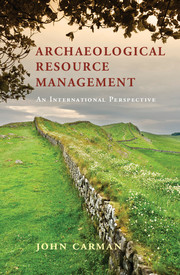6 - Preservation
from Part II - Practices
Published online by Cambridge University Press: 05 September 2015
Summary
While there is a widespread assumption that the preferred option for archaeological resources is their protection from degradation and destruction, there is in reality very little in the literature of ARM to justify this. It is of little help in understanding what this imperative to preserve means and involves that a range of different terms are also used to describe it: preservation (this volume; Carman 2002; Lozny 2008), conservation (Clark 2001) and protection (Cleere 1984; Messenger and Smith 2010), among others. In addition to this, there are the different forms of preservation that are offered: preservation in situ (Corfield et al. 1998), preservation ‘by record’ (Wainwright 1989, 168–9) and reconstruction, a very specific form of archaeological presentation (Stone and Planel 1999), all of which may have different names in different territories. The issue of preservation, of course, also assumes its opposite, destruction, and it has long been held that excavation is itself destructive (Wheeler 1954, 15). However, there are now arguments being made by archaeologists that what we have thought of as a bad thing is merely another form of transformation, something of which we are guilty whatever we do to components of the archaeological record (Lucas 2001b, 40). Holtorf (2005) and, elsewhere, I (Carman 2013, 750) argue that both preservation and destruction ultimately serve the same purpose: that to preserve or to destroy something is respectively to destroy or preserve something else, be it another object, an idea or a way of life. In the case of preserving or destroying, the question is not about the rightness of the action in itself, but about what thereby is being preserved or destroyed instead.
These are the issues that this chapter will address from the perspective of the role these various practices play in the archaeological project but also the regulatory and institutional contexts in which they are located. The next section will return us to concerns that first appeared in Chapter 3, with how preservation is reflected in laws that govern archaeology. The following section will examine how it relates to issues of ownership and custodianship, issues that underpin so much archaeological work. The section after that will look at the practical means of preservation that may be applied, and a final section will review the work that the preservationist project does in the world, what it means that we preserve our material in these various ways.
Legal mechanisms
As indicated in Chapter 3, every country in the world has laws that relate to its archaeological resources, and these generally cover a range of topics that relate to how these materials will be managed. A shared principle that lies behind their existence is the belief that archaeological remains are (a) important and (b) therefore the responsibility of public (usually equated with state) institutions.
- Type
- Chapter
- Information
- Archaeological Resource ManagementAn International Perspective, pp. 131 - 155Publisher: Cambridge University PressPrint publication year: 2015

